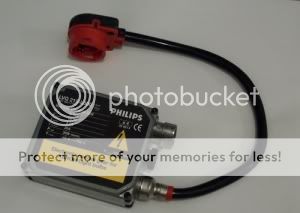Luke (liveforphysics) and I have an ongoing project to hack these and make them do different power levels and possibly change their shape (to fit into a flashlight tube). I thought some people might be interested to know what exactly is inside the little "black box."
I will post pics of our progress here if people are interested. Right now I am still working out the details, but maybe later I can post a rough schematic/guide to show how this thing works. Thanks to Luke for supplying the ballast that gave its life so that we might have... fun.:bow:
The first pic is just the top of the ballast after the potting is removed (big job!). The design is pretty standard: the 12 V input gets converted to around 90 V by a flyback converter and rectifier. Then that gets converted to a square-wave output by a full-bridge. The ignition circuit rides on the full-bridge, producing 25 kV pulses via a capacitor/spark-gap/transformer combo. This particular ballast uses current-mode control for the flyback. I have not yet found out how it senses lamp current.

That's all for now.... more to come later...
I will post pics of our progress here if people are interested. Right now I am still working out the details, but maybe later I can post a rough schematic/guide to show how this thing works. Thanks to Luke for supplying the ballast that gave its life so that we might have... fun.:bow:
The first pic is just the top of the ballast after the potting is removed (big job!). The design is pretty standard: the 12 V input gets converted to around 90 V by a flyback converter and rectifier. Then that gets converted to a square-wave output by a full-bridge. The ignition circuit rides on the full-bridge, producing 25 kV pulses via a capacitor/spark-gap/transformer combo. This particular ballast uses current-mode control for the flyback. I have not yet found out how it senses lamp current.

That's all for now.... more to come later...
Last edited:



 :rock:
:rock:




